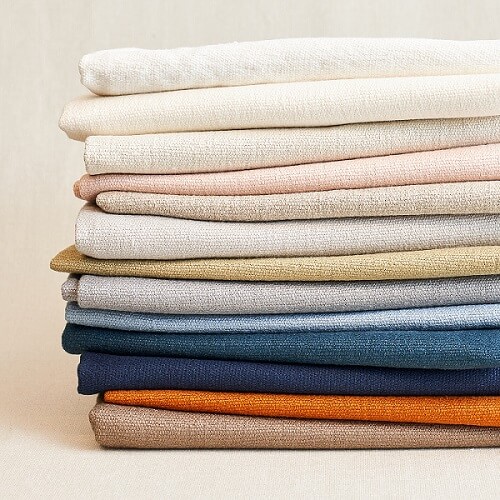Coated fabric: It is a kind of fabric treated by special technology. It can…
How to Prevent Clothes from Fading in the Wash?
Clothes fading in the wash is a problem we often encounter, making people headache, so, what are the common situations where clothes fade in the wash? How to prevent clothes from fading in the wash? This article will solve your doubts once and for all.
Table of Contents
★ The principle of the clothes fading after washing
The reason why the clothes lose colour after washing because the combination of dyes and clothing fibres is not strong, which leads to weak dyeing, it is related to the fabric structure of the clothing, the dyes and the dyeing process, washing method and so on.

Clothes come in different materials – cotton, linen, polyester, wool, nylon and so on. Because different fibres have different molecular structures, they need to be dyed with different pairs of dyes. Different dyes also have different ways of dyeing and different dyes bond with the fibres differently, all of which may cause the clothes to lose colour in the wash.
★ Common situations where clothes fade after washing
In general, textiles woven from natural fibres are more likely to lose colour and dyed than chemical textiles. This means that cotton, linen, silk and wool textiles are more likely to lose colour than nylon, polyester, acrylic and so on. The common situations that the clothes fading after washing are listed below.
1 Cotton clothes are prone to fading after washing
Cotton fibre dyeing commonly used reactive dyes, this dye has a lot of reactive groups on it, which will have a partial reaction with the water molecules with hydroxyl groups to form a floating phenomenon, adsorbed on the clothes. If the clothes are not washed sufficiently in the production, then this layer of floating will always be on the clothes, and when consumers buy and wear them after washing, they will wash this layer of floating down and feel that the colour is seriously lost.

2 Wool clothes are prone to lose colour after washing
Wool fabrics have different causes of fading to cotton fabrics. Wool is often dyed with acid dyes, because wool is a protein fibre, under acidic conditions, the proteins are positively charged and the negatively charged acidic dyes can then be electrically attracted to the wool, creating a positive and negative attraction and binding it together. However, most everyday detergents are alkaline, which means that the wool protein becomes negatively charged during the washing process and is then repelled by the acidic dyes, resulting in some of the dyes falling off and colour loss.
3 Fading after washing of jeans
Jeans are more prone to fading than the common cotton garment. This is because the yarn in jeans is so thick and chunky that it is difficult for the dye to get inside the fibres, resulting in little dye inside the fibres and a lot gathering on the surface. These dyes on the surface are very insecure and can easily fall off.

4 Clothes with textile chemicals may lose colour
Clothes are not only dyed, but in order to get a better feel or other properties, just like a girl’s make-up, we also add a lot of additives to our clothes, such as anti-UV agents, anti-static agents, softeners, moisture-absorbing and quick-drying agents and so on. For example, silicone oil, which is used to soften clothes, is an oil-based substance that can dissolve water-insoluble disperse dyes and cause colour loss.

Note: The side effects of additives such as these do not only cause colour loss, silicone oil with its softening properties, while making the fabric feel soft and smooth, but also reduces yarn-to-yarn friction, which means that yarns can slip easily and clothes are more likely to tear.
★ Pay attention to the washing label instructions on your clothes
As well as being aware of fading caused by the clothes and the dyes themselves, we also need to understand the caveat of the laundry itself. This is something that many people overlook, and this caution is the label on the garment.

It’s even more important to know the washing labels than the fabric of your clothes! Let’s take a look at some of the wash labels we often encounter in our lives.

Wash markings: generally a reminder of the water temperature and another thing to look out for is the hand wash and do not wash.

Bleach markings: we should pay special attention, do not think that bleach is only used by dry cleaners, we should also pay attention to whether there is added bleach ingredients in the laundry detergent, laundry detergent, check and pay attention when washing clothes to avoid unnecessary losses.

Ironing markings: as shown in the picture, one dot means 110℃, two dots mean 150℃ and three dots mean 200℃. Especially in women’s clothing stores, you should pay attention to such signs, too high a temperature during ironing can distort the fabric.

Cleaning solvents markings: we have seen a lot of these markings, but may not use them, these are special instructions for the use of cleaning solvents, which need to be communicated with the dry cleaner in advance when sending to dry cleaning, and must be cleaned separately.

Did you know that over-drying is one of the biggest damages we can do to our clothes? These drying symbols can help you choose the cycle and temperature of your dryer to minimise damage. Don’t underestimate these drying requirements, some clothes are really “delicate” and if you are worried about fading and distortion, it is better to follow the above requirements.
After learning about labels, the next step is to share some tips on how to prevent fading in your laundry in life, specifically for clothes that tend to lose colour and are prone to staining.
★ How to prevent clothes from fading in the wash?
1 Industrial solutions
The most direct solution to fading in production is to use colour fixers, such as resins or quaternary ammonium salts, which strengthen the connection between the dye and the fibre, enhancing the fixing power and thus reducing fading. Alternatively, a more reactive or direct dye can be used to improve the colour fastness to washing and reduce fading.
As to whether the color fastness to washing meets the relevant requirements, we need to do a test of color fastness to washing of textile, which actually uses the same kind coloring principle to assess the color fastness to washing of the fabric.

In addition, nowadays, with the development of technology, color film to prevent color cascading is also very effective, which is mainly a cationic modified non-woven fabric. The non-woven fabric has an excellent adsorption effect, plus it is modified to carry cations, so it can be better combined with dye adsorption to prevent colour cascading. When washing, add 1 to 3 colour film depending on the amount of clothes to prevent colour cascading.
2 Household solutions
It’s a headache to lose colour, and it’s even more of a headache when the colour comes off and stains another garment, which is mainly because it is stained on the same type of clothes. For example, cotton clothes that lose colour will not stain polyester clothes, only cotton clothes, so it is best not to wash similar clothes of different colours together.
The best situation is of course to wash different colours separately, but this would be too time consuming and costly. You can put your old white towels and white clothes in the wash together. These white clothes will absorb most of the floating colours, which cannot be completely avoided, but the colour cascading will be much better. Also, if the clothes are not particularly dirty, do not use warm water to wash them, cold water is better to reduce the precipitation of dyes.
2.1 First way to prevent fading: the acid wash method

Ingredients needed: cooking vinegar. This method is mainly for brightly coloured cotton clothes and knitwear such as red or purple. Before washing these clothes, add some plain vinegar to the water and soak for a while! If you wash your clothes this way regularly, you will be able to keep them looking as good as new. But be careful not to use too much, otherwise the clothes will smell like vinegar when they are dry.
2.2 Second way to prevent fading: the Florida water cleaning method

Ingredients needed: Florida water. This method is more suitable for cotton and woollen fabrics. First, wash your clothes in the usual way, rinse them well, add a few drops of Florida water to the water and soak the cleaned clothes in this water for ten minutes. Washing clothes in this way will also disinfect and remove the smell of sweat.
2.3 Third way to prevent fading: the salt water soak method

Ingredients needed: salt. Soaking in salt does have an effect as it reduces the ZATA potential between the dye and the cotton fibre, makes the dye less likely to come off. However, the concentration of salt must be at least 60 g/L, which is not economical. The key thing is that it only works on cotton, linen and viscose fibres, other fibres are counterproductive such as acrylic, wool and silk, which will accelerate the shedding of the dye.
2.4 Fourth way to prevent fading: tea soaking

Ingredients needed: herbal tea water. This method is suitable for the problem of fading in jumpers. After brewing tea, the tea contains theophylline and other substances, which can be used to deal with the problem of fading in jumpers. Let the tea water cool first, then put the discoloured jumper into the soak, soak for a while and then wash it with the normal procedure, which can effectively solve the problem of fading of jumpers.
2.5 The fifth way to prevent fading: the reverse drying method

This method is most commonly used and is particularly effective for dark coloured clothes. The method is very simple: turn your clothes inside out to dry. A special reminder: most fabrics should not be exposed to sunlight directly, as UV rays are the main culprit for fading. So not only should turn your clothes inside out to dry, you should also try to dry them in a light and airy place if possible.
Have you learnt all this? The next time you wash your clothes, pay more attention to the requirements of the label to clean clothes, so that the life of the clothes will be longer, I hope these tips in life can help you solve the problem of clothes fading when washing clothes.




This Post Has 0 Comments